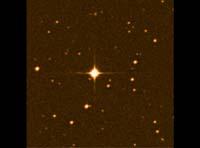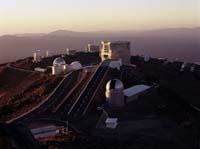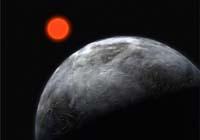An exoplanet similar to Earth

The star Gliese 581 is a red dwarf. (Photo: ESO))
News of the planets that have the possibility of having life in the media appear from time to time, by not having solid evidence, they lose their echo immediately. This time it is different, on the one hand, because the astronomers that have detected have been prudent in raising the hypotheses, and on the other, because this exoplanet is more like the Earth than those that have been detected so far.
The exoplanet orbits around a star near the Sun. Gliese 581 is the name of this star, as the astronomer Gliese was 581st in the star catalogue of more than 81.5 light years of the Sun. It is 20.5 light-years from the solar system, that is, at the speed of light (300,000 meters per second) it takes 20 and a half years to arrive. Like most of the nearby stars, it is a red dwarf, with a mass three times smaller than the Sun and that emits heat and light 50 times weaker than those of the Sun.
Although the star does not have much strength, the heat and light it emits are enough for there to be opportunities to create life on the planet. And it is that this planet is 14 times closer to its star than the Sun. Thus, astronomers have calculated that on the surface of the planet are between 0-40ºC, so in case there was water it would be in liquid state and in addition it would be possible the presence of living beings, with enough light and heat.
Still few data
However, they have no indication to think there is water and much less to imagine that there can be living beings. In fact, they still have few facts about the planet. They know that their mass is 5 times bigger than that of the Earth, so it is the smallest exoplanet they have detected so far (the mass of the smallest so far was 5.5, but it is far from its star). But they do not know, for example, their size. If it were rocky, its radio would be 50% higher than on Earth, but to know, astronomers have to have some luck.

The Chair of Chile has been detected with bdiez of the HARPS tool of the observatory. (Photo: ESO))
And, depending on the method of observing stars and planets, they receive different information. Usually they do not observe directly the exoplanets, for this they are too small, they are too far away and are hidden by the nearby stars. Therefore, they use indirect ways: through the changes that occur in the signal they receive from the observed star, astronomers know that they have a planet around and, to a certain extent, how that planet is.
For example, the HARPS tool of the Chilean observatory La Silla has detected the current exoplanet. This tool measures the radial velocity, so that the planet released the ‘vibrations’ detected at the speed of the star. With the data obtained, the mass of the planet has been calculated, but from there they cannot deduce its composition. To do this, they must follow the orbit of the planet and observe its passage ahead of the star. But the probability of this happening is only 2%.
However, the HARPS is very good for finding exoplanets. As is very precise, astronomers use it to search for planets with a small mass (up to twenty times greater than that of the Earth) and have had a great success: they have detected a total of 13, of which 11 have been thanks to the HARPS tool.
They know something else about the planet: how long a year lasts. Only 13 days! Little, at least compared to the planets of the Solar System, the shortest year is Mercury, which is the closest to the Sun and has an approximate duration of 88 days. However, that same star has another planet, even closer and even shorter than they have perceived. Your year lasts only 5.4 days.
Another solar system

In the artistic image, an exoplanet similar to the Earth and behind the star Gliese 581. (Photo: ESO))
In addition to this planet close to the star, Gliese 551 has another. Both were detected a couple of years ago, but they were not explained so much in the media, since in them it is impossible for there to be life. One is too close to the star and the other too far. The first is very large, has a mass 15 times larger than that of the Earth and the other is 8 times larger than the Earth. This takes 84 days to complete the orbit around the star.
In any case, Gliese 551 and these three planets form a kind of solar system, another similarity between the Earth and the exoplanet they have just detected. Astronomers who believe there are possibilities to live on the exoplanet want to advance in research. According to them, this exoplanet must be taken into account in future life search missions.
In these missions, they intend to place telescopes in space to collect indications that are related to biological processes such as methane remains in the atmosphere of exoplanets or chlorophyll, a pigment used by Earth plants to perform photosynthesis. But that will be in the future.
Published in Gara.
Buletina
Bidali zure helbide elektronikoa eta jaso asteroko buletina zure sarrera-ontzian











